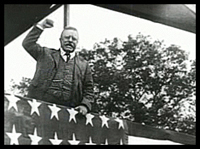This is the last of three Challenge articles addressing the activities of the Federal Agencies Digitization Guidelines Initiative, this time with a focus on the Audio Visual Working Group.
Books, photographic slides, audio tapes: these and other documentary materials require specialized techniques to create long-term, sustainable digital versions. Developing best practices for digitizing sound, video recordings and motion picture film is the specific challenge faced by the Audio-Visual Working Group, a component of the Federal Agencies Digitization Guidelines Initiative.
The Library of Congress is participating in the working group along with the Defense Imagery Management Operations Center (Department of Defense), the Institute of Museum and Library Services, the National Aeronautics and Space Administration, the National Agricultural Library, the National Archives and Records Administration, the National Library of Medicine, the Smithsonian Institution, the Government Printing Office, and the Voice of America.
Because of the specialized issues involved, the working group is divided into two separate areas of focus: recorded sound and moving image.
Guidelines for recorded sound will draw on publications from organizations and activities such as the International Association of Sound and Audiovisual Archives, the National Recording Preservation Board, the Sound Directions project at Indiana and Harvard universities and others. The goal is to build on existing work, identify new issues in need of study, and come up with a set of overall recommendations for the digitization of sound recordings.

Historical film footage of Theodore Roosevelt, an example of the rare films in the Library's collection.
While digital reformatting for recorded sound is relatively mature, digital file-based preservation approaches for video recordings and motion picture film are less well established. "There is quite a range of experience in the audio-visual realm," says Carl Fleischhauer, a Program Officer at the Library of Congress and an organizer of the working group. "Most specialists are confident about what to do regarding sound, but we are still sorting out the details for video and film. The work that is now under way in some of our federal agencies will provide the experience we need to begin recommending practices to others."
One key challenge is to develop a good approach for the preservation reformatting of historical videotape. Most videotape held by federal agencies is in analog form but there are also holdings of digital videotape dating from the mid-1990s. "In all cases," Fleischhauer says, "archivists wish to break away from the current practice of tape-to-tape copying, and begin to transfer content from tapes to digital files."
The next step will be to identify the best "target" file formats for the transfer of video to digital files. "At least three federal agencies are beginning to transfer video to MXF files with picture information encoded as JPEG 2000 frame images," says Fleischhauer. "The working group will study practical experience from implementing the standards to see what refinements ought to be investigated." At the same time, the group will look at the video preservation practices being developed in the public television community in a project that has received NDIIPP support.

At NARA's College Park audio-visual digitization facility: room with specialized equipment used to reformat videotapes.
The working group meetings feature presentations as well as discussion. At the February 2009 meeting, held at NARA in College Park, Md, NASA specialists from the Johnson Space Center in Houston discussed their experience with digital scanning of motion picture film. The meeting also included a tour of the NARA audio-visual preservation facility, which includes video, film, and audio transfer capabilities.
The digital conversion of film in the future will benefit from work being carried out today by the motion picture industry. "The film studios in Hollywood are pushing to standardize digital film production, including film scanning," Fleischhauer commented. "There is some great technical work being carried out under the auspices of the Science and Technology Council at the Academy of Motion Picture Arts and Sciences." A portion of this investigation is also receiving NDIIPP support.
The Federal Agencies Digitization Guidelines Initiative Web site will continue to reflect current activities, with new recommended guidelines for each format posted as soon as available. For the Audio-Visual Working Group, there will be separate documents for sound recordings, video recordings, and motion picture film.

